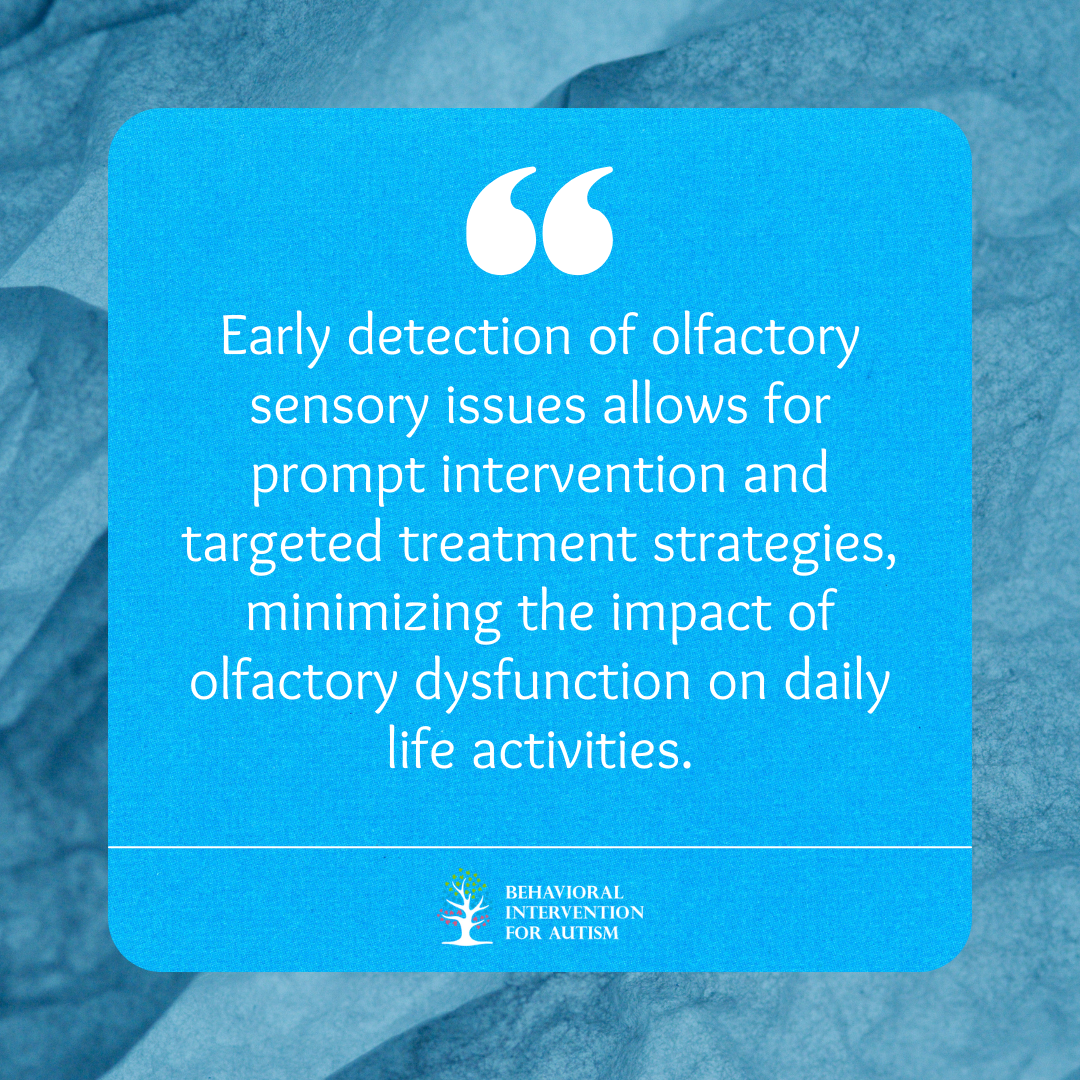
Table of Contents
Exploring the challenges related to olfactory sensory issues, it is important to understand the manifestations of olfactory dysfunction in individuals within the autism spectrum.
The focus is on olfactory dysfunction in Autism Spectrum Disorder (ASD) and sensory processing dysfunction (SPD).
Olfactory Dysfunction in ASD
Research indicates that children with Autism Spectrum Disorder (ASD) often exhibit differences in their olfactory abilities compared to typically developing children. Specifically, children with ASD show reduced odor identification ability but intact odor detection. This suggests alterations in secondary olfactory processing brain regions in individuals with ASD.
The relationship between olfactory dysfunction and ASD symptomatology is notable. Studies have found that children with ASD who experience greater challenges in odor identification also tend to display more severe ASD symptoms, particularly in the domain of social deficits. This implies a shared mechanism linking sensory and social symptoms in individuals with ASD.
Olfactory Dysfunction in SPD
On the other hand, children with Sensory Processing Dysfunction (SPD) present with their own set of olfactory challenges. Unlike children with ASD who primarily exhibit issues in odor identification, those with SPD demonstrate difficulties in both odor detection and identification abilities. This suggests dysfunction at the level of primary olfactory processing in individuals with SPD.
Olfactory disorders impact both children with ASD and SPD, but in distinct ways. Children with ASD often exhibit altered olfactory function compared to their typically developing peers, while those with SPD experience impairments in odor detection thresholds and identification. Recognizing these differences in olfactory sensory challenges is essential for tailoring effective interventions and support strategies for individuals with ASD and SPD.

Correlation with ASD Symptoms
The relationship between olfactory sensory issues and Autism Spectrum Disorder (ASD) reveals that these sensory challenges directly affect social deficits in individuals with ASD.
Furthermore, the severity of olfactory dysfunction is closely associated with the overall symptomatology of ASD.
Impact on Social Deficits
Children with ASD often exhibit reduced odor identification ability while maintaining intact odor detection compared to typically developing children. This signifies alterations in secondary olfactory processing brain regions, indicating a unique sensory processing difference. The correlation between poor odor identification ability and the severity of autism symptoms in children with ASD emphasizes the profound influence of olfactory dysfunction on social deficits commonly observed in individuals with ASD.
Severity of Olfactory Dysfunction
Research indicates that children with ASD who have significant odor identification dysfunction often exhibit more severe symptoms, especially in social deficits. This correlation underscores a shared mechanism underlying both sensory challenges and social symptoms of ASD. Moreover, the degree of olfactory dysfunction seems to be associated with the severity of autism symptoms, indicating a potential connection between olfactory issues and the overall ASD phenotype.

Types of Olfactory Disorders
Olfactory sensory challenges can lead to various types of olfactory disorders, classified as conductive and neural. Each type has distinct characteristics and implications.
Conductive Olfactory Disorders
Conductive olfactory disorders refer to conditions that hinder the physical transport of odorants to the olfactory receptors, thereby impacting the individual’s ability to perceive smells accurately. These disorders often stem from issues within the nasal cavity or sinuses, obstructing the passage of odor molecules to the olfactory epithelium.
Symptoms of conductive olfactory disorders may include a reduced sense of smell, hyposmia, or anosmia (complete loss of smell). Conditions such as nasal polyps, sinus infections, or anatomical abnormalities can contribute to the development of conductive olfactory disorders, highlighting the importance of proper evaluation and treatment by healthcare professionals.
Neural Olfactory Disorders
Neural olfactory disorders pertain to conditions that affect the neural pathways involved in olfactory processing, disrupting the transmission of olfactory signals from the olfactory receptors to the brain. Damage to the olfactory neuroepithelium, as seen in post-URI anosmia or toxin-induced injuries, can lead to neural olfactory disorders.
Individuals experiencing neural olfactory disorders may encounter difficulties in odor identification, discrimination, or interpretation, impacting their overall olfactory perception. These disorders highlight the intricate interplay between sensory mechanisms and neural processing in the olfactory system, emphasizing the need for comprehensive assessment and management strategies tailored to the specific type of olfactory disorder presented by each individual.
Management and Treatment
Navigating the challenges of olfactory sensory issues in the autism community requires a thoughtful approach to management and treatment. Understanding the available options can significantly impact the well-being of individuals with autism spectrum disorder (ASD).
We examine three key strategies for managing olfactory sensory issues: antibiotic therapy, the benefits of acupuncture, and the importance of early detection.
Antibiotic Therapy
Addressing olfactory dysfunction in individuals with autism spectrum disorder may involve utilizing antibiotic therapy. Bactericidal antibiotic therapy has shown promise in partially mitigating chronic decrements in smell sensitivity related to nasal inflammatory disorders. Research suggests that bactericidal antibiotics are more effective than bacteriostatic antibiotics, particularly in patients with upper respiratory infections or rhinosinusitis.
Considering the potential impact of nasal inflammatory conditions on olfactory function, antibiotic therapy can play a vital role in improving smell sensitivity and overall olfactory health in individuals with ASD. Collaborating with healthcare providers to determine the most appropriate antibiotic regimen is essential for tailored and effective treatment.
Acupuncture Benefits
Another promising approach to managing olfactory sensory issues in individuals with autism is through acupuncture. Studies have indicated that acupuncture, specifically laser needle acupuncture, can enhance olfactory threshold sensitivity in normal subjects. The effects of acupuncture on olfactory function have been shown to last for more than an hour, highlighting its potential as a non-invasive and beneficial treatment modality.
The use of acupuncture as a complementary therapy for olfactory dysfunction presents a holistic and alternative option for individuals with autism spectrum disorder. By exploring acupuncture benefits, individuals and caregivers can consider integrating this practice into a comprehensive treatment plan to address olfactory sensory challenges effectively.
Early Detection Importance
Understanding the significance of early detection in olfactory disorders is essential for enhancing the quality of life for individuals with autism and sensory issues. Olfactory disorders are prevalent in the general population, affecting a significant percentage of individuals. Research indicates that about one-third of patients seeking professional help for olfactory issues report significantly diminished life quality, leading to reduced well-being and decreased quality of life.

Olfactory sensory issues, often experienced by individuals with autism, can lead to heightened sensitivity to certain smells or a complete lack of response to others. These sensitivities can impact daily activities and overall comfort. At Behavioral Intervention for Autism, we offer tailored ABA programs in Florida to help individuals navigate these challenges and improve their quality of life.
Our team uses evidence-based strategies to create personalized treatment plans that address each individual’s sensory needs. If you’re interested in how we can support you or your loved one, contact us to learn more about our compassionate and effective services.
- 9 Common Obsessions of Children With Autism You Should Know - February 25, 2025
- What is Neurodiversity? A Guide to Embracing Differences - February 25, 2025
- Understanding Hyperfocus in Autism: What It Means and Why It Happens - February 25, 2025
